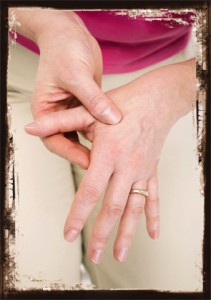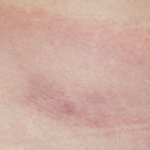
RA is typically symmetric and, early on, usually involves the small joints
of the hands and feet.
Image Credit: Lea Paterson / Science Source
What struck me first as I walked by the exam room where Lynn P. sat was the swelling in her fingers and wrists. The bloated hands rested unnaturally on her thighs, palms up, fingers slightly flexed. Her strawberry-blond curls were offset by a high-neck, loose-fitting, burgundy sweater. Her pale skin matched her trim slacks. She had an air of straightforward expectation, as if she might hold out her misshapen hands and ask if she could have a refund for another, better functioning, pair.
Outside the room, I picked up the chart and skimmed through the notes her internist had forwarded: Two months post-partum…uncomplicated pregnancy …healthy 7 lb., 6 oz. boy … breastfeeding, abrupt-onset swelling of fingers and wrists. Next visit: Swelling increased in fingers, worse in am, toes, ankles, knees stiff … Ibuprofen, minimal benefit. And then: Trouble holding baby, lab studies okay, getting worse by the day. Rheumatology referral.
I turned to the information sheet she’d filled out: 27 years old, born in Portland, Maine. Married. First pregnancy. No significant past medical history. No surgeries. No allergies. Non-smoker. I can see where she crossed out her original answer, no alcohol, to well, I had a glass of wine last week to see if it could help me sleep, but no luck!
Ever so gingerly, I shook her hand as I entered the room. The wrists and fingers were a boggy, swollen mass of inflammation. She limply withdrew her hand and thanked me for seeing her on short notice. Only then did I notice the baby in the carrier tucked under the table at her feet.
Post-Partum-Onset Inflammatory Arthritis
The mysterious onset of inflammatory arthritis beginning shortly after childbirth has a limited differential diagnosis. It’s mysterious in that affected women usually have no history of previous health problems, the delivery was uncomplicated and the baby is completely well. In the usual case, the patient has had no change in diet or unusual exposures, no preceding illness or warning. One day, the new mother is well, the next her joints begin to stiffen and swell.
I mulled over the possibilities. Despite the absence of the usual signs—fever, cough, rash, diarrhea—perhaps Lynn P.’s swollen joints were manifestations of infection. As I examined her neck for signs of lymph node enlargement and palpated her abdomen, I recalled that Parvovirus B-19 may trigger incapacitating arthritis. True, most patients have a prodrome of fever and rash, but from time to time, I’ve seen patients who lack these typical signs. It’s worth checking for. Lyme disease? No, wrong joint distribution and her Lyme test was non-reactive.
Rheumatologists often arrive at a definitive diagnosis in a decidedly low-tech fashion. Patiently teasing out a complete history narrows the possible explanation for the patient’s symptoms. The distribution of tender or swollen joints also helps. … Rheumatoid arthritis typically is symmetric …
I mulled over the other possibilities. Occasionally, a reaction to a prescription medication or other connective tissue disorders, such as lupus or scleroderma, may present in this fashion, but as I examined her heart and lungs and checked her skin for a subtle rash, I was convinced these were unlikely as well.



